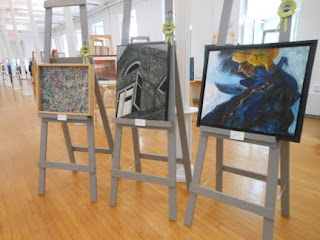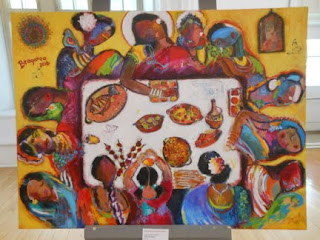 |
| Patchwork, pieced, made of hand-dyed cotton, 16" x 16" |
I chose the Klee painting
Senecio as my starting point. I always assumed it represented a child, but then I learned that the title can be translated as "Old Man", from the Latin, "senescere", or "to grow old". Still, I find the colours suggest youth and light-heartedness. From this painting, I chose my palette, and I also used some of its simple curves and shapes.
 |
| Senecio, Paul Klee, oil paint on gauze, 1922 |
As the final assignment for the
Jane Davies course Beyond the Colour Wheel, participants were asked to take the small, 3-colour collages we had made and "tile" them together. In other words, to take those 3" squares or rectangles and put them onto a grid, with no spaces between, just to see what they looked like arranged as a group. So my response to the 12 by the dozen challenge also met the criteria for the last assignment of my on-line course.
Many of
Klee's paintings suggest a patchwork or a mosaic, with small square-ish shapes "tiled" to form a kind of loose grid, so my use of a grid is also a reference to Klee. I tried to use the colours in more or less the same proportion that Klee used them in
Senecio.
In summary, I'd say that I like the original painting, I like the colours, I like the shapes, and I like the idea of a grid. But somehow the whole is less than the sum of its parts. In fact it's a hot mess: Klee's image put through a blender. I think that without the organizational structure of a recognizable face, the piece has no unity. Klee's painting has a variety of small, medium and large shapes. My patchwork has only small and smaller. It's one thing to fulfill the requirements of a class assignment or a group challenge, but it's another thing to make good work.
























